Immunohistochemistry Catalog
Primary antibodies
PLAP (Placental alkaline phosphatase)
Clone: P16-D
Cat#: DB 047
P16-D is useful in the identification of testicular germ cell tumors. The antibody shows no cross-reaction with other isoenzymes of alkaline phosphatases.

Fixed-embedded human seminoma
Podoplanin
Clone: D2-40
Cat#: 10081
D2-40 is selectively expressed in lymphatic endothelium as well as lymphangiomas, Kaposi's sarcomas and in a subset of angiosarcomas with probable lymphatic differentiation. Podoplanin has also been shown to be expressed in epithelioid mesotheliomas, hemangioblastomas and seminomas.

Fixed-embedded human tonsil
Progesterone receptor (PgR)
Clone: X22-C
Cat#: DB 108
PgR is an estrogen-regulated protein. It has been proposed that expression of PgR indicates a responsive ER pathway, and therefore, may predict likely response to endocrine therapy in human breast cancer. A number of studies have shown that PgR determination provides supplementary information to ER, both in predicting response
to endocrine therapy and estimating survival.
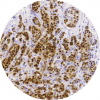
Fixed-embedded human breast cancer
Renal cell carcinoma
Clone: PN-15
Cat#: 10138
The antigen is expressed on the brush border of proximal renal tubules and on the luminal surface of Bowman's capsule, as well as in parathyroid parenchymal cells and colloid of thyroid follicles. The antibody is useful for the identification of malignant cells from primary and metastatic renal cell carcinomas.
S-100 protein
Clone: D28-E
Cat#: DB 055
Antibody to S100 stains schwannomas, ependymomas, astrogliomas, nevi and almost all malignant melanomas and their metastases. S100 protein is also expressed in the antigen presenting cells such as the Langerhans cells in skin and interdigitating reticulum cells in the paracortex of lymph nodes.

Fixed-embedded human neurofibroma
Synaptophysin
Clone: Q21-Q
Cat#: 10098
Synaptophysin is a neuronal synaptic vesicle glycoprotein that is expressed in neuroendocrine cells and neoplasms. Synaptophysin contains four trans-membrane domains that form a hexameric channel or gap junction-like pore.

Fixed-embedded human vegetative ganglion
TGF-α
Clone: P/T1
Cat#: 10025
P/T1 antibody is useful for the detection of TGF-α production in human tumor cells and immunoserological monitoring of progression of malignant tumors.
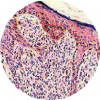
Fixed-embedded human melanoma
Thyroid Transcription Factor (TTF-1)
Clone: G21-G
Cat#: DB 089
TTF-1 is useful in differentiating primary adenocarcinoma of the lung from metastatic carcinomas from the breast, mediastinal germ cell tumors and malignant mesothelioma. It can also be used to differentiate Small cell lung carcinoma from lymphoid infiltrates. Loss of TTF-1 expression in non -small cell lung carcinoma has been associated with aggressive behavior of such neoplasms.

Fixed-embedded human thyroid
TNF-α
Clone: P/T2
Cat#: 10026
This mouse monoclonal antibody labels the cytoplasm of TNF-alpha secreting cells including macrophages.
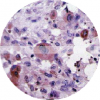
Fixed-embedded human histiocyta/macrophag
Wilms' tumor 1 (WT1) protein
Clone: 6F-H2
Cat#: 10048
This mouse monoclonal antibody reacts on WT1 protein, which has been identified in proliferative mesothelial cells, malignant mesothelioma, ovarian cystadeno-carcinoma, gonadoblastoma, nephroblastoma and desmoplastic small round cell tumor. The WT1 gene is normally expressed in fetal kidney and mesothelium, and its expression has been suggested as a marker for Wilm's tumor and mesothelioma. Lung adenocarcinoma is rarely positive with this antibody.
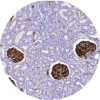
Fixed-embedded human kidney
β-Catenin
Clone: 14
Cat#: 10073
β-Catenin is normally found in the cytoplasm of the cell in sub-membranous location. Mutations in the β-Catenin gene result nuclear accumulation of this protein, which has been demonstrated in fibrous abdominal and breast lesions, therefore is useful ín different iating these lesions from other spindle cell proliferations that may occur in these locations.
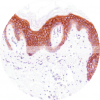
Fixed-embedded human skin

